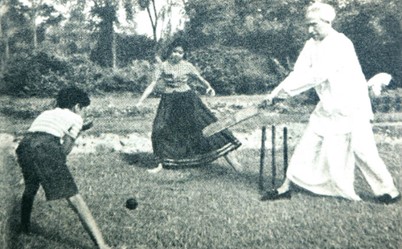Title Thumbnail: Dr.Radhakrishnan on a visit to Moscow in 1964, source: www.rbth.com, accessed date: Dec.08, 2020. Hero Image: Sarvepalli Radhakrishnan, source: httpsL//indianexpress.com, access date: Dec.08, 2020.
Indian Philosophy Volume 2
First revision: Dec.08, 2020
Last change: May 20, 2024
In the grand chapter of both books of knowledge, I have brought together an essential piece of Great Guru's work, well famous. His Excellency S. Radhakrishnan came to translate, add explanations and illustrations, revisit with respect from the book "INDIAN PHILOSOPHY Volume 1 and 2," requesting consideration highly. I was bringing the works of Master Guru, who is in Heaven Or the high world with a richly detailed spectrum to publish to those interested in studying.
I wish to dedicate all that I may have received to Father Leun and Mother Anong Kanchanakongkha, who deeply love my first two teachers.
Apirak Kanchanakongkha
September 30, 2020
OXFORD INDIA PAPERBACKS
INDIAN PHILOSOPHY
Volume 2
 A rare picture of Dr. S. Radhakrishnan playing cricket with his grandchildren.
A rare picture of Dr. S. Radhakrishnan playing cricket with his grandchildren.
Source: https://starofmysore.com , access date December 11, 2020.
S Radhakrishnan
OXFORD INDIA PAPERBACKS
INDIAN PHILOSOPHY Volume 2
--------------------------------------------------------------------------------
S. Radhakrishnan
Long acknowledged as a classic, this pioneering survey of Indian thought charts a fascinating course through an intricate history. From the Rig Veda to Ramanuja, Radhakrishnan traces the development of Indian philosophy while showing its growth as a single tradition of thought through the ages. Individual philosophers and their views are interpreted in the light of this broad argument. Throughout, the author’s concern is to show ancient philosophical texts at their best and relate these to contemporary issues of philosophy and religion. The essential elements of individual texts and philosophies are emphasized in order to prevent meaning and significance from being obscured by detail. Parallels between Indian and Western philosophical traditions are also regularly drawn.
The writing is extremely lucid and therefore accessible to general readers. This volume covers the six Brahmanical system.
S. Radhakrishnan was a distinguished philosopher, statesman and writer. He is the translator of The Dhammapada (OUP), and he was for many years a professor at Oxford University, before becoming the President of India.
INDIAN PHILOSOPHY
INDIAN PHILOSOPHY
BY
S. RADHAKRISHNAN
VOLUME II
OXFORD
UNIVERSITY PRESS
OXFORD
UNIVERSITY PRESS
YMCA Library Building, Jai Singh Road, New Delhi 110001
Oxford University Press is a department of the University of Oxford. It furthers the University’s objective of excellence in research, scholarship, and education by publishing worldwide in
Oxford New York
Athens Auckland Bangkok Bogota Buenos Aires Calcutta
Cape Town Chennai Dar es Salaam Delhi Florence Hong Kong Istanbul
Karachi Kuala Lumpur Madrid Melbourne Mexico City Mumbai
Nairobi Paris Sao Paulo Singapore Taipei Tokyo Toronto Warsaw
with associated companies in
Berlin Ibadan
© Oxford University Press 1999
First published in 1923
Revised edition 1929 Indian edition 1940
Published by George Alien & Unwin Ltd.
This edition published in India 1989
by arrangement with the original publisher
Seventh impression 1994
Oxford India Paperbacks 1996
Fifth impression 1999
ISBN 019 563820 4
Printed in India at Rekha Printers Pvt Ltd, New Delhi 110 020
and published by Manzar Khan, Oxford University Press
YMCA Library Building, Jai Singh Road, New Delhi 110 001
PREFACE TO THE SECOND EDITION
I HAVE utilised the opportunity offered by the Second Edition to correct a number of minor errors and misprints, and to extract in a few doubtful and difficult cases the Sanskrit originals so as to enable the reader to compare the interpretations with the text. These latter are found in the Notes at the end of the book, which also include material intended to clear up difficulties or bring the book up-to-date.
The English renderings of Sanskrit texts are generally based on standard translations where available, and these are mentioned in the bibliographical references. These latter are intended mainly as a guide to the literature available in English, though they indirectly point the way to the whole literature on the subject.
I have to thank many friends and critics for their valuable suggestions. I am specially indebted to Professor M. Hiriyanna of Mysore. Among others who helped me with valuable advice are Mahāmahopādhyāya N.S. Anantakrishna Śāstri of Calcutta. My friend and colleague, Mr. K. C. Chatterji, checked the references, and my thanks are due to him.
September 1930.
10
PREFACE TO THE FIRST EDITION
IN this volume, which is devoted to the discussion of the six Brahmanical systems, I have adopted the same plan and method of treatment as in the first. I have tried to adopt, what is acknowledged to be, the true spirit of philosophical interpretation, viz., to interpret the ancient writers and their thoughts at their best and relate them to the living issues of philosophy and religion. Vācaspati Miśra, who commented on almost all the systems of Hindu thought, wrote on each, as if he believed in its doctrines. In presenting intelligently tendencies of thought matured long ago and embodied in a number of difficult works, it has been necessary to select, emphasise and even criticise particular aspects, which naturally betrays the direction in which my own thinking runs. Involving as the work does so many decisions on points of detail, it is, perhaps, too much to hope that the book is free from errors of judgement ; but I have endeavoured to give an objective treatment and avoid playing tricks with the evidence.
I should repeat here that my discussion is not to be regarded as complete in any sense of the term, for almost every chapter deals with a subject to which a fully equipped specialist devotes a lifetime of study. Detailed discussions of particular systems require separate monographs. My task is the limited one, of sketching in broad outlines the different movements of thought, their motives and their results. I have mode practically no attempt to deal with secondary variations of opinion among the less important writers of the various schools. My treatment of Śaiva, the Śākta and the later Vaiṣṇava systems, which belong more to the religious
11
history than to the philosophical of India, has been brief and summary. I shall be thoroughly satisfied if I succeed in conveying an idea, however inadequate, of the real spirit of the several phases of Indian speculative thought.
If this volume is slightly more difficult than the previous one, I hope it will be felt that the difficulty is not entirely of my making, but is to some extent inherent in the subject and in the close thinking which its study involves. To condense a mass of facts into a clear narrative which can be followed by the reader without bewilderment or boredom is a task which I felt to be more than what I could compass. It is for the reader to judge how far I have succeeded in my attempt to steer a middle course between looseness and pedantry. To help the general reader, the more technical and textual discussions are printed in small type.
In the preparation of this volume I have found, not only the Sanskrit texts of the different schools, but also the writings of Deussen and Keith, Thibaut and Garbe, Gangānāth Jhā and Vidyābhūṣaṇ, very helpful. I am greatly indebted to my friends, Mr. V. Subrahmanya Aiyar and Professor J. S. Mackinzie, for their kindness in reading considerable parts of the MS. and the proofs, and making many valuable suggestions. Professor A. Berriedale Keith was good enough to read the proofs, and the book has profited much by his critical comments. My deepest thanks, however, are due, as in the case of the first volume, to the General Editor, Professor J. H. Muirhead, who gave to the work much of his time and thought. But for this generous assistance, the defects of the book – whatever they may be – would have been very much greater. The printing of the work involved considerable trouble, and I am glad that it has been extraordinarily well done.
December 1926
CONTENTS
| |
PAGE |
| PREFACE TO THE SECOND EDITION |
. . . . . . |
5 |
| PREFACE TO THE FIRST EDITION |
. . . . . . |
7 |
|
PART III
|
| THE SIX BRAHMANICAL SYSTEMS |
|
CHAPTER I
|
| INTRODUCTION |
. . . . . . . . . . |
17 |
| |
The spirit of the age – The Darśanas – Āstika and Nāstika – Sūtra literature – Date – Common ideas – The six systems. |
|
|
CHAPTER II
|
| THE LOGICAL REALISM OF THE NYĀYA . . . . . |
29 |
| |
The Nyāya and Vaiśeṣika – The beginnings of the Nyāya – Literature and history – Aim and scope – The nature of definition – Perception – Its analysis and kinds – Inference – Syllogism – Introduction – Causation – Plurality of causes – Asatkāryavāda – Criticism of the Nyāya view of causation – Comparison – verbal knowledge – Authoritativeness of the Vedas – Other forms of knowledge – Aitihya and Arthāpatti, Saṁbhava and Abhāva – Tarka, Vāda, Nigrahasthāna – Memory – Doubt – Fallacies – Truth, its nature and criterion – Theories of error – The Nyāya theory of knowledge examined – The world of nature – The individual soul – Saṁsara – Mokṣa – Criticism of the Nyāya theory of soul and its relation to consciousness – Ethics – Proofs for the existence of God – Conclusion. |
|
|
CHAPTER III
|
| THE ATOMISTIC PLURALISM OF THE VAIŚEṢIKA. . . |
176 |
| |
The Vaiśeṣika – Date and literature – Theory of knowledge – Categories – Substance – Soul – Manas – Space – Time – Ākāśa -Earth, water, light and air – The atomic theory – Quality – Activity – Generality – Particularity – Inherence – Non-existence – Ethics – Theology – General estimate. |
|
CHAPTER IV |
| |
PAGE |
| THE SĀṀKHYA SYSTEM |
. . . . . . . . . |
248 |
| |
Introduction – Antecedents – Literature – Causality – Prakṛti – Guṇas – Cosmic evolution – Puruṣa – The relation between Puruṣa and Prakṛti – The problem of knowledge – Jīva – Ethics – Release – God – Is Sāṁkhya atheistic? – General estimate. |
|
|
CHAPTER V
|
| THE YOGA SYSTEM OF PATAÑJALI . . . . . . |
336 |
| |
Introduction – Antecedents of the Yoga system – Date and literature – The Sāṁkhya and the Yoga – Psychology – The means of knowledge – The art of Yoga – Ethical preparation – The discipline of the body – Regulation of breath – Sense-control – Contemplation – Concentration – Freedom – Karma – Supernormal powers – Theism of the Yoga - Conclusion. |
|
|
CHAPTER VI
|
| THE PŪRVA MĪMĀṀSĀ . . . . . . . . . |
374 |
| |
Introduction – Date and literature – The sources of knowledge – Perception – Inference – Scriptural testimony – Comparison – Implication – Non-apprehension – Theory of Knowledge: Prabhākara, Kumārila – The self: Prabhākara, Kumārila – Nature of reality – Ethics – Apūrva – Mokṣa – God – Conclusion. |
|
|
CHAPTER VII
|
| THE VEDĀNTA SŪTRA . . . . . . . . . |
430 |
| |
The Vedānta and its interpretations – Authorship and date of the Sūtra – Relation to other schools – Brahman – The world – The individual self - Mokṣa - Conclusion. |
|
|
CHAPTER VIII
|
| THE ADVAITA VEDĀNTA ŚAṀKARA . . . . . . |
445 |
| |
Introduction – Date – Life and personality of Śaṁkara - Literature – Gauḍapāda’s Kārikā – Buddhist influence – Analysis of experience – Causation – Creation – Ethics and religion – relation to Buddhism – General estimate of Gauḍapāda’s position – Bhartṛhari – Bhartṛprapañca – Śaṁkara’s relation to the Upaniṣads and the Brahma Sūtra – Relation to Buddhism and other systems of philosophy – The reality of Ātman – Its nature – Theory of knowledge – Mechanism of Knowledge – Perception, its nature and varieties – Inference – Scriptural testimony – Refutation of subjectivism – Criterion of truth – Inadequacy of logical knowledge – Self-consciousness – Adhyāsa – Anubhava - |
|
PAGE
| |
Scriptural authority – Higher wisdom and lower knowledge - Śaṁkara and Kant, Bergson and Bradley – The objective approach – Reality and existence – Space, time and cause – The world of phenomena – Brahman - Saguṇa and Nirguṇa – Īśvara -Proofs for the existence of God – Brahman and Īśvara – Personality – Creation – The phenomenal character of Īśvara – Being, not-being and becoming – The phenomenality of the world and illusion? – Avidyā and māyā – The world of nature – The individual self - Sākṣin and jīva – Brahman and jīva - Avacchedavāda – Bimbapratibimbavāda - Ethics – Charges of intellectualism and asceticism considered – Jñāna and Karma – Karma and freedom - Mokṣa – Future life – Religion - Conclusion. |
|
|
CHAPTER IX
|
| THE THEISM OF RĀMĀNUJA . . . . . . . . |
659 |
| |
Introduction – The Puranas – Life – History and literature – Bhāskara – Yādavaprakāśa – The Pramāṇas – Implications of Ramanuja’s theory of knowledge – God – The individual soul – Matter – Creation – Ethics and religion – Mokṣa – General estimate. |
|
|
CHAPTER X
|
| THE ŚAIVA, THE ŚĀKTA, AND THE LATER VAIṢṆAVA THEISM |
722 |
| |
Śaiva Siddhānta – Literature – Metaphysics, ethics and religion The Pratyabhijñā system of Kashmir – Śāktaism – The dualism of Madhva – Life and literature – Theory of knowledge – God – Soul – Nature – God and the world – Ethics and religion – General estimate – Nimbārka and Keśava – Vallabha – Caitanya, Jīva Gosvāmi and Baladeva. |
|
|
CHAPTER XI
|
| CONCLUSION . . . . . . . . . . . |
766 |
| |
The course of Hindu philosophic development – The unity of the different systems – The decline of the philosophic spirit in recent times – Contract with the West – The present situation – Conservatism and radicalism – The future. |
|
| NOTE . . . . . . . . . . . . |
783 |
| INDEX . . . . . . . . . . . . |
793 |
15
|
LIST OF ABBREVIATIONS
|
| B.G. |
. . . |
Bhagavadgītā. |
| B.S. |
. . . |
Brahma Sūtra. |
| D.S.V. |
. . . |
Deussen’s System of Vedānta – E.T. |
| I.P. |
. . . |
Indian Philosophy, Vol. I. |
| N.B. |
. . . |
Nyāya Bhāṣya. |
| N.S. |
. . . |
Nyāya Sūtra. |
| N.V. |
. . . |
Nyāyavārttika. |
| N.V.T.T. |
. . . |
Nyāyavārttikatātparyaṭīkā. |
| P.P. |
. . . |
Padārthdharmasaṁgraha of Praśastapāda. |
| M.S. |
. . . |
Mīmāṁsā Sūtra. |
| P.M. |
. . . |
Pūrva-Mīmāṁsā Sūtras. |
| R.B. |
. . . |
Rāmānuja’s Bhāṣya on the Brahma Sūtra. |
| R.B.G. |
. . . |
Rāmānuja’s Bhāṣya on the Bhagavadgītā. |
| S.B. |
. . . |
Śaṁkara’s Bhāṣya on the Brahma Sūtra. |
| S.B.G. |
. . . |
Śaṁkara’s Bhāṣya on the Bhagavadgītā. |
| S.K. |
. . . |
Śāṁkhya Kārikā. |
| S.B.H. |
. . . |
Sacred Books of the Hindus. |
| S.L.S. |
. . . |
Siddhāntaleśasaṁgraha. |
| S.P.B. |
. . . |
Śāṁkhyapravacana Bhāṣya. |
| S.P.S. |
. . . |
Śāṁkhyapravacana Sūtra. |
| S.D.S. |
. . . |
Sarvadarśanasaṁgraha. |
| S.S.S.S. |
. . . |
Sarvasiddhāntasārasaṁgraha. |
| S.V. |
. . . |
Ślokavārttika. |
| V.S. |
. . . |
Vaiśeṣika Sūtra. |
| Y.B. |
. . . |
Yoga Bhāṣya. |
| Y.S. |
. . . |
Yoga Sūtra. |



